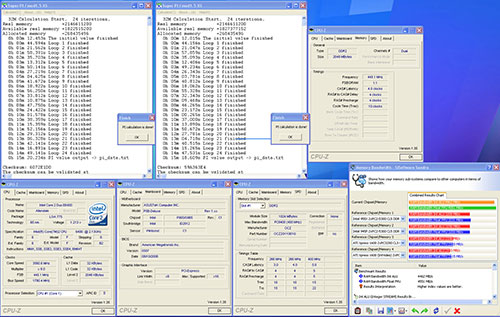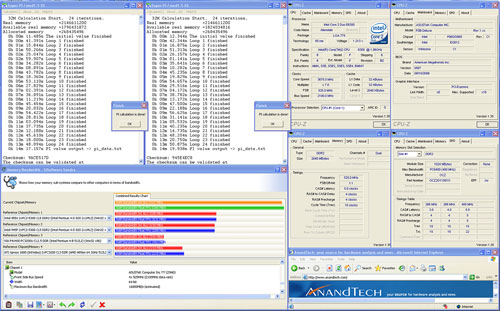ASUS P5B: New BIOS Adds Unlocking & Improved Overclocking
by Wesley Fink on August 24, 2006 3:00 PM EST- Posted in
- Motherboards
As more experience has been gained in overclocking Core 2 Duo chips, it is becoming clear that the 4MB cache E6700 and E6600 do not overclock quite as well as the 2MB Cache chips. There is not a huge difference in the overclocking of 2MB and 4MB at each multiplier, but there is a small advantage to the 2MB design for overclocking. Keep in mind, however, that 2MB performance is lower, so that tends to offset any advantage the 2MB E6400 and E6300 designs might enjoy.
E6400
The E6400 starts at 8x266 or 2.13GHz. With the new 507 BIOS we managed to reach stable speeds of 445x8, 511x7, and 514x6. This composite should give you a better idea of performance at a FSB of 445x8. There is a huge amount of capture information in this image, so you will need to click to enlarge it to readable size.
The jump from 2.13GHz to 3.58GHz is an amazing overclock of 1449MHz, or almost 1500 MHz. Percentage wise, this is a bit more than 68%. With the new ASUS BIOS, we now have the ability to do similar overclocks with the bus speed. With the 6400 the bus speed can now be adjusted from 266 to 514, which represent s a potential bus speed overclock of 93% - almost double the stock 266 FSB speed.
E6300
At $183 the E6300 represents the best value among the Core 2 Duo processors. The 65nm architecture combined with a low starting speed of 1.83GHz presents buyers with some amazing overclocking potential. These capabilities are enhanced further with the ASUS 0507 BIOS.
The E6300 unlocked down and reached 525x7 at stock multiplier. We were very near the limits of the ASUS P5B with the new BIOS and Scythe Infinity air cooling since dropping to x6 only gained us a few more MHz on the FSB, namely 532 at 6X. This is a100% bus overclock and it clearly demonstrates the added flexibility of the lower speed Core 2 Duo chips.
While the 2MB cache E6400 and E6300 reached higher bus speeds and CPU clocks than the 4MB E6700 and E6600, keep in perspective that the 4MB versions perform faster clock for clock. Any advantage the 2MB might have in our testing is small and is more than offset by the 4MB performance advantage. Still, the 2MB models are definitely impressive overclockers and they are both excellent values in the Core 2 Duo line-up.
E6400
The E6400 starts at 8x266 or 2.13GHz. With the new 507 BIOS we managed to reach stable speeds of 445x8, 511x7, and 514x6. This composite should give you a better idea of performance at a FSB of 445x8. There is a huge amount of capture information in this image, so you will need to click to enlarge it to readable size.
 |
| Click to enlarge |
The jump from 2.13GHz to 3.58GHz is an amazing overclock of 1449MHz, or almost 1500 MHz. Percentage wise, this is a bit more than 68%. With the new ASUS BIOS, we now have the ability to do similar overclocks with the bus speed. With the 6400 the bus speed can now be adjusted from 266 to 514, which represent s a potential bus speed overclock of 93% - almost double the stock 266 FSB speed.
E6300
At $183 the E6300 represents the best value among the Core 2 Duo processors. The 65nm architecture combined with a low starting speed of 1.83GHz presents buyers with some amazing overclocking potential. These capabilities are enhanced further with the ASUS 0507 BIOS.
 |
| Click to enlarge |
The E6300 unlocked down and reached 525x7 at stock multiplier. We were very near the limits of the ASUS P5B with the new BIOS and Scythe Infinity air cooling since dropping to x6 only gained us a few more MHz on the FSB, namely 532 at 6X. This is a100% bus overclock and it clearly demonstrates the added flexibility of the lower speed Core 2 Duo chips.
While the 2MB cache E6400 and E6300 reached higher bus speeds and CPU clocks than the 4MB E6700 and E6600, keep in perspective that the 4MB versions perform faster clock for clock. Any advantage the 2MB might have in our testing is small and is more than offset by the 4MB performance advantage. Still, the 2MB models are definitely impressive overclockers and they are both excellent values in the Core 2 Duo line-up.










84 Comments
View All Comments
ZachSaw - Thursday, August 24, 2006 - link
"the ability to unlock the previously locked Conroe chips is so significant that every other manufacturer will have to follow the ASUS lead or lose market share to the motherboard giant."LOL. Perhaps ASUS is the one who is the follower. All of Gigabyte's 965 boards have had this ability since the very beginning. ASUS had to release an update to their BIOS to support this, after seeing Gigabyte's feature.
In any event, this is a VERY SIMPLE function to implement -- what innovation? It simply uses the EIST feature in your CPU to implement multiplier "unlock". In fact, it's technically wrong to say "unlock", since we don't lock the multiplier you managed to select in the first place! That's the whole point of EIST. Unless you can select upwards, then you can claim to have unlocked the multiplier. Otherwise, it's just legally and technically a wrong term to use. You can claim to support Multiplier Adjustment, but do not EVER say it's unlocked. Be warned.
Please clean up your article. Too many mistakes.
Also, it'll be good to put a foreword in your article to mention that your oc is based on Engineering Samples (B1 step), which are different from retail (B2). Retail ones have some differences which make it a little faster clock to clock, but not as overclockable. You do not want people to rush out to buy those processors, based on your table of overclocked frequencies.
Madellga - Thursday, August 24, 2006 - link
Correct. Reviews like this should be based on Retail samples, not Golden Cherry Picked units.Otherwise people are misled by the results.
Frumious1 - Thursday, August 24, 2006 - link
Yeah, "Golden Cherry Picked units" like the freaking RETAIL E6400 and E6300 stepping B2 that overclocked higher than the "cherry" ES B1 E6600/E6700? OMFG the world is coming to an end!!!The only thing potentially misleading is that the B2 E66/6700 might do better than shown here. The bottom line is that the B2 is a later, IMPROVED stepping that should actually at least match these results.
The Gigabyte information is more of a problem, but given my experience with a DS3 I can't say I'm too happy with GB right now. F4 seems to have cleared up most of the problems. F2 was an absolute joke, however.
ZachSaw - Thursday, August 24, 2006 - link
You simply do not know enough. B2 is a later step, no doubt. But, who says later steps increase oc-potential??? It's pretty weird how the community came to this "conclusion". It might be true for later steps (C and above), but usually not the earlier ones such as B1 and B2. So don't jump to conclusions when you have never tested out A0 parts before.
All I'm asking them to do is, to use retail parts. That's all.
Frumious1 - Thursday, August 24, 2006 - link
Maybe you can pull some strings with Intel and get them to send new B2 or later retail samples to Anandtech? I'm sure the AT guys don't want to go out and buy a bunch of new CPUs when the current ones work fine. We all recognize that there is an element of marketing to hardware enthusiast sites - that's why there are a shitload of ads at all the sites, right? (Thank you, AdBlock!) AMD and Intel (and Asus, Gigabyte, Asrock, etc.) send parts for free to AT and they review them. "No such thing as bad publicity!"You keep ignoring the fact that the E63/6400 were NOT B1/ES steppings, and yet they overclocked better. That's where I drew my conclusions. Sure, less cache has an impact, but at the very least it's safe to say B1 isn't amazingly better than B2. Anyway, all overclocks are largely CPU dependent. Everyone in the community knows that. YMMV: Your Mileage May Vary. That the P5B hits 500+ MHz FSB is more than enough for me. I don't particularly like to run at "mostly stable" settings, so if I can POST and run most benches at a 68% OC, I'll drop to 50% for 100% stability and peace of mind. $185-$200 for a chip that can match stock X6800 performance is pretty tasty.
shecknoscopy - Thursday, August 24, 2006 - link
1) How is it possible that they can do this? I thought the multiplier lock was something phyiscally hard-wired in the manufacture of the processor - akin to those graphics cards that absolutely cannot unlock extra pipes.2) Any chance that we'll see it appearing on the other ASUS conroe boards? Or is the answer to (1) intricately linked to the north bridge?
3) How about other manufacturers? Now that ASUS has set the stage, are we going to see the Gigabyte (or what's left of 'em), MSI, DFI, etc... boards following suit? Or is this patentable technology?
4) Anyone else had it with these <explicative> snakes on this <explicative> plane? I wish someone would do something about them, already....
-Sheq
ZachSaw - Thursday, August 24, 2006 - link
Write a few bytes into the MSR. Read the PRM of conroe. You'll find out how easy it actually is. Under Windows, you'll need a driver's help to access MSRs, but the BIOS has complete access to MSRs.
ASUS followed Gigabyte -- AFAIK, Gigabyte already has this feature since they introduced 965P-series boards. They did it so early that they didn't need any updates.
Sh0ckwave - Thursday, August 24, 2006 - link
I can confirm this. I just tried it on my DS3 with and E6400. I was able to set the multi to 6, 7, and 8.Calin - Friday, August 25, 2006 - link
Who knows, after the Gigabyte-Asus union (partial union with a manufacturing purpose), maybe they do share some know-howtombomba2 - Thursday, August 24, 2006 - link
Sorry, but as long as anandtech doesn't have conroes which can be unlocked up, I think this is a very questionable feature of the board.